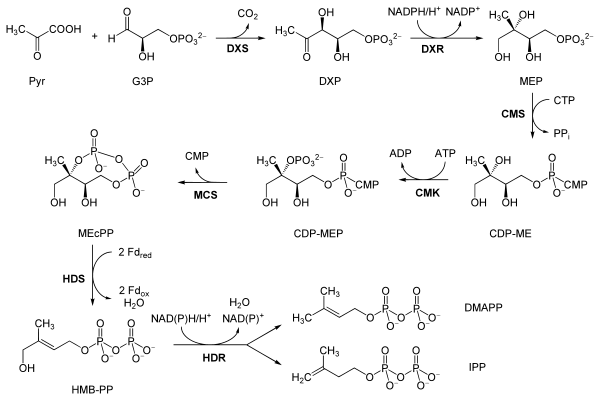Non-mevalonate pathway
The non-mevalonate pathway—also appearing as the mevalonate-independent pathway and the 2-C-methyl-D-erythritol 4-phosphate/1-deoxy-D-xylulose 5-phosphate (MEP/DOXP) pathway—is an alternative metabolic pathway for isoprenoid biosynthesis that forms isopentenyl pyrophosphate (IPP) and dimethylallyl pyrophosphate (DMAPP).[1][2][3]
Diversity of isoprenoid biosynthesis
The classical mevalonate pathway or HMG-CoA reductase pathway is an important cellular metabolic pathway present in all higher eukaryotes and some bacteria. It is important for the production of IPP and DMAPP, which serve as the basis for the biosynthesis of molecules used in processes as diverse as protein prenylation, cell membrane maintenance, hormone synthesis, protein anchoring and N-glycosylation.
In contrast to the classical mevalonate pathway of isoprenoid biosynthesis, bacteria, plants, and apicomplexan protozoa—such as malaria parasites—are able to produce isoprenoids (including the dimeric isoprenoids, the terpenoids) using an alternative pathway, the non-mevalonate pathway; in the case of the eukaryotic protozoans and plants, the biosynthesis takes place in their plastid organelles.[4] Bacteria that use the pathway include important pathogens such Mycobacterium tuberculosis.[5]

Reactions
The reactions of the non-mevalonate pathway are as follows, taken primarily from Eisenreich and co-workers, except where the bold labels are additional local abbreviations to assist in connecting the table to the scheme above:[7][6]
| Reactants | Enzyme | Product | |
| Pyruvate (Pyr) and glyceraldehyde 3-phosphate (G3P) | DOXP synthase (Dxs; DXR) | 1-Deoxy-D-xylulose 5-phosphate (DOXP; DXP) |  |
| DOXP (DXP) | DOXP reductase (Dxr, IspC; DXR) | 2-C-methylerythritol 4-phosphate (MEP) |  |
| MEP | 2-C-methyl-D-erythritol 4-phosphate cytidylyltransferase (YgbP, IspD; CMS) | 4-diphosphocytidyl-2-C-methylerythritol (CDP-ME) |  |
| CDP-ME | 4-diphosphocytidyl-2-C-methyl-D-erythritol kinase (YchB, IspE; CMK) | 4-diphosphocytidyl-2-C-methyl-D-erythritol 2-phosphate (CDP-MEP) | |
| CDP-MEP | 2-C-methyl-D-erythritol 2,4-cyclodiphosphate synthase (YgbB, IspF; MCS) | 2-C-methyl-D-erythritol 2,4-cyclodiphosphate (MEcPP) |  |
| MEcPP | HMB-PP synthase (GcpE, IspG; HDS) | (E)-4-Hydroxy-3-methyl-but-2-enyl pyrophosphate (HMB-PP) |  |
| HMB-PP | HMB-PP reductase (LytB, IspH; HDR) | Isopentenyl pyrophosphate (IPP) and Dimethylallyl pyrophosphate (DMAP) |   |
Inhibition and other pathway research
DOXP reductoisomerase (DXP reductoisomerase, MAP synthase), a key enzyme in the non-mevalonate pathway, is inhibited a natural product, fosmidomycin, which is under study as a starting point to develop a candidate antibacterial or antimalarial drug.[8][9][10]
The intermediate, HMB-PP, is a natural activator of human Vγ9/Vδ2 T cells, the major γδ T cell population in peripheral blood, and cells that "play a crucial role in the immune response to microbial pathogens".[11]
References
- ↑ Rohmer M; Rohmer, Michel (1999). "The discovery of a mevalonate-independent pathway for isoprenoid biosynthesis in bacteria, algae and higher plants". Nat Prod Rep. 16 (5): 565–574. PMID 10584331. doi:10.1039/a709175c.
- ↑ W. Eisenreich; A. Bacher; D. Arigoni; F. Rohdich (2004). "Review Biosynthesis of isoprenoids via the non-mevalonate pathway". Cellular and Molecular Life Sciences. 61 (12): 1401–1426. PMID 15197467. doi:10.1007/s00018-004-3381-z.
- ↑ Hunter, WN (2007). "The Non-mevalonate Pathway of Isoprenoid Precursor Biosynthesis" (PDF). Journal of Biological Chemistry. 282 (30): 21573–21577. doi:10.1074/jbc.R700005200. Retrieved March 23, 2017.
- ↑ Lichtenthaler H (1999). "The 1-Deoxy-D-xylulose-5-phosphate pathway of isoprenoid biosynthesis in plants". Annu Rev Plant Physiol Plant Mol Biol. 50: 47–65. PMID 15012203. doi:10.1146/annurev.arplant.50.1.47.
- ↑ Wiemer, AJ; Hsiao, CH; Wiemer, DF (2010). "Isoprenoid Metabolism as a Therapeutic Target in Gram-Negative Pathogens". Current Topics in Medicinal Chemistry. 10 (18): 1858–1871. PMID 20615187.
- 1 2 Qidwai T, Jamal F, Khan MY, Sharma B (2014). "Exploring Drug Targets in Isoprenoid Biosynthetic Pathway for Plasmodium falciparum" (review). Biochemistry Research International: 657189. PMC 4017727
 . doi:10.1155/2014/657189. Retrieved March 23, 2017.
. doi:10.1155/2014/657189. Retrieved March 23, 2017. - 1 2 Eisenreich W, Bacher A, Arigoni D, Rohdich F (2004). "Biosynthesis of Isoprenoids Via the Non-mevalonate Pathway". Cell. Mol. Life Sci. 61 (12): 1401–26. PMID 15197467. doi:10.1007/s00018-004-3381-z.
- ↑ Hale I, O'Neill PM, Berry NG, Odom A & Sharma R (2012). "The MEP pathway and the Development of Inhibitors as Potential Anti-Infective Agents" (review). Med. Chem. Commun. 3: 418–433. doi:10.1039/C2MD00298A. Retrieved March 23, 2017.
- ↑ Jomaa H, Wiesner J, Sanderbrand S, et al. (1999). "Inhibitors of the Nonmevalonate Pathway of Isoprenoid Biosynthesis as Antimalarial Drugs". Science (primary research report). 285 (5433): 1573–6. PMID 10477522. doi:10.1126/science.285.5433.1573.
- ↑ C. Zinglé; L. Kuntz; D. Tritsch; C. Grosdemange-Billiard; M. Rohmer (2010). "Isoprenoid Biosynthesis via the Methylerythritol Phosphate Pathway: Structural Variations around Phosphonate Anchor and Spacer of Fosmidomycin, a Potent Inhibitor of Deoxyxylulose Phosphate Reductoisomerase". J. Org. Chem. (primary research report). 75 (10): 3203–3207. doi:10.1021/jo9024732.
- ↑ Eberl M, Hintz M, Reichenberg A, Kollas AK, Wiesner J, Jomaa H (2003). "Microbial Isoprenoid Biosynthesis and Human γδ T cell Activation" (minireview). FEBS Lett. 544 (1-3): 4–10. PMID 12782281. doi:10.1016/S0014-5793(03)00483-6. Retrieved March 23, 2017.
Further reading
- Hale I, O'Neill PM, Berry NG, Odom A & Sharma R (2012). "The MEP pathway and the Development of Inhibitors as Potential Anti-Infective Agents" (review). Med. Chem. Commun. 3: 418–433. doi:10.1039/C2MD00298A. Retrieved March 23, 2017. RSC review; uses MAP synthase nomenclature.
- Qidwai T, Jamal F, Khan MY, Sharma B (2014). "Exploring Drug Targets in Isoprenoid Biosynthetic Pathway for Plasmodium falciparum" (review). Biochemistry Research International: 657189. PMC 4017727
 . doi:10.1155/2014/657189. Retrieved March 23, 2017.
. doi:10.1155/2014/657189. Retrieved March 23, 2017.
.svg.png)